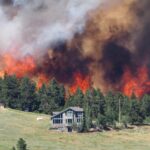With the wildfires, increasing carbon dioxide levels, and gas driven polluting products, Metro Denver and Fort Collins are ranked high as one of the worst air polluters. According to Environmental Protection Agency (EPA), Metro Denver ranked eighth worst for ozone levels, up from 10th in 2020. Fort Collins increased to 17th worst, up from 19th in 2020.

Wildfires
In June, Metro Denver and other northern Front Range cities were facing air quality alerts including Denver Metro, Rocky Mountain National Park, and Fort Collins.
Across Colorado, ozone pollution has increased due to a warming climate, wildfires, and various gas driven products. Wildfires spread lots of dangerous smoke, and the wildfires in Colorado have made our ozone levels worse. Gas driven products such as vehicles, lawn equipment, and industrial equipment have contributed to the ozone problem.
The EPA and American Lung Association recommend a minimum limit for ozone levels along with the World Health Organization. Colorado hasn’t met the recommended ozone levels for several years. The Environmental Protection Agency (EPA) officials last year classified Colorado as a serious polluter.
Colorado is considering new regulations and recommendations in an effort to reduce ozone pollution including 1) requiring landscaping companies and homeowners to stop using gas-powered lawn mowers, weed cutters and other tools and convert to electric lawn equipment, 2) reducing high-pollution vehicles by offering incentives for electric vehicles, and 3) eliminating older regulations to lower ozone levels across Colorado.
The EPA and American Lung Association have been lobbying the President and Congress to promote electric vehicles and their charging stations including providing tax credits, rebates and free use of charging stations and highway express lanes.
